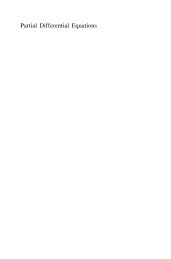a Matlab package for phased array beam shape inspection
a Matlab package for phased array beam shape inspection
a Matlab package for phased array beam shape inspection
You also want an ePaper? Increase the reach of your titles
YUMPU automatically turns print PDFs into web optimized ePapers that Google loves.
8 3 ANTENNA GAIN<br />
To proceed, assume that the pulse Eq. (3), though not monochromatic, is strongly bandlimited<br />
around ω 0 , so that we can replace ωu in the exponential factor of Eq. (21) by<br />
ω 0 u. When that is the case, Eq. (21) factors as the undistorted pulse multiplied by the<br />
<strong>array</strong> factor:<br />
∫<br />
z = (<br />
dωS ω e −iωt ) × ∑ e i ω 0<br />
c (û−û 0 )·R m<br />
= s(t, 0, û) × AF . (22)<br />
When is it possible to approximate ωu by ω 0 u in Eq. (21)? A sufficient condition is<br />
that over the bandwidth of the wave (that is, in the frequency-zone where Sû(ω) is<br />
significantly non-zero) the phase angle error<br />
δψ = ω − ω 0<br />
û · R m<br />
c<br />
caused by the approximation stays small compared to unity, everywhere on the <strong>array</strong>.<br />
Because<br />
| ω − ω 0<br />
û · R m | ≤ 2πB<br />
c<br />
c L , (23)<br />
where B is the pulse bandwidth and L is the maximum dimension of the <strong>array</strong>, we see<br />
that a sufficient condition <strong>for</strong> the most desirable fundamental result Eq. (22) to hold to<br />
a good approximation, <strong>for</strong> all incoming wave directions, is<br />
2πB<br />
c L ≪ 1 . (24)<br />
The bandwidth of a transmitted pulse in reception is a essentially the inverse of the<br />
rise time of the pulse, so Eq. (24) says that meaningful phase-steering requires that the<br />
time L/c to illuminate the <strong>array</strong> from end to end must be substantially smaller than the<br />
characteristic time 1/B <strong>for</strong> the wave amplitude to change. That is, illumination changes<br />
must be “essentially instantaneous” over the whole <strong>array</strong>. For example, <strong>for</strong> the planned<br />
E3D <strong>array</strong> with maximum dimension of the order of L ∼ 150 m, phase steering would be<br />
distortion-free only <strong>for</strong> signal bandwidths that are substantially smaller than 300 kHz.<br />
This looks like a good motivation <strong>for</strong> not to even consider phase-steering <strong>for</strong> the E3D<br />
<strong>array</strong>; nevertheless, I think it would be of interest to augment GJ’s system simulation<br />
software to handle phase-steering also, to see just how bad those distortions actually are<br />
<strong>for</strong> typical modulations.<br />
For the rest of this document, and everywhere in the e3ant <strong>package</strong>, we will simply<br />
assume that the distortions are not so serious as to badly compromise Eq. (22). With that<br />
assumption, the <strong>array</strong> response is the same <strong>for</strong> all signals, and is given by the <strong>array</strong> factor<br />
AF via Eq. (22). To handle <strong>beam</strong> <strong>for</strong>ming and <strong>beam</strong> steering in this approximation, it<br />
is there<strong>for</strong>e neither necessary nor useful to include the signals explicitly.<br />
3. Antenna gain<br />
3.1. Transmission<br />
As a consequence of a regular placement of <strong>array</strong> elements, the gain pattern of an <strong>array</strong><br />
may have “grating lobes”. That is, there may be are several widely separated “sidelobes”<br />
of maximally large gain, so that it appears that the gain pattern has several main lobes.<br />
With isotropic elements—the only case we consider in this section—the all the grating
















